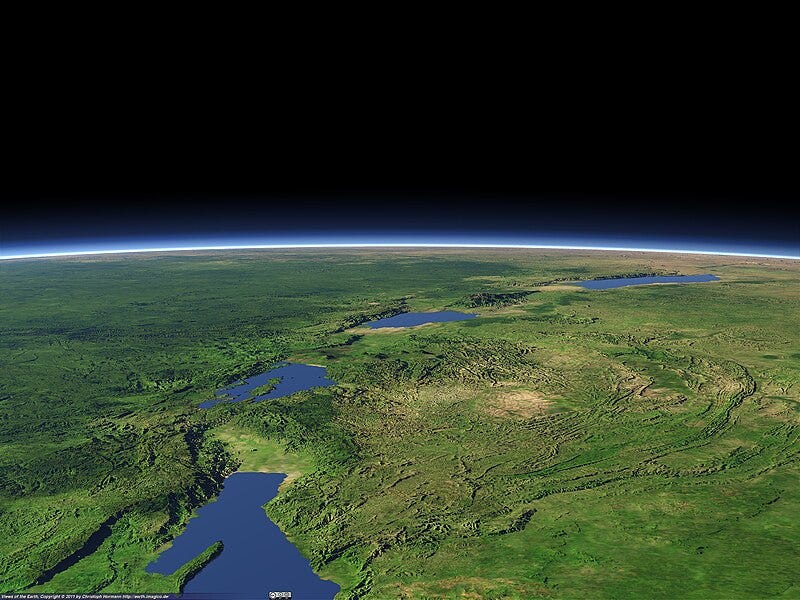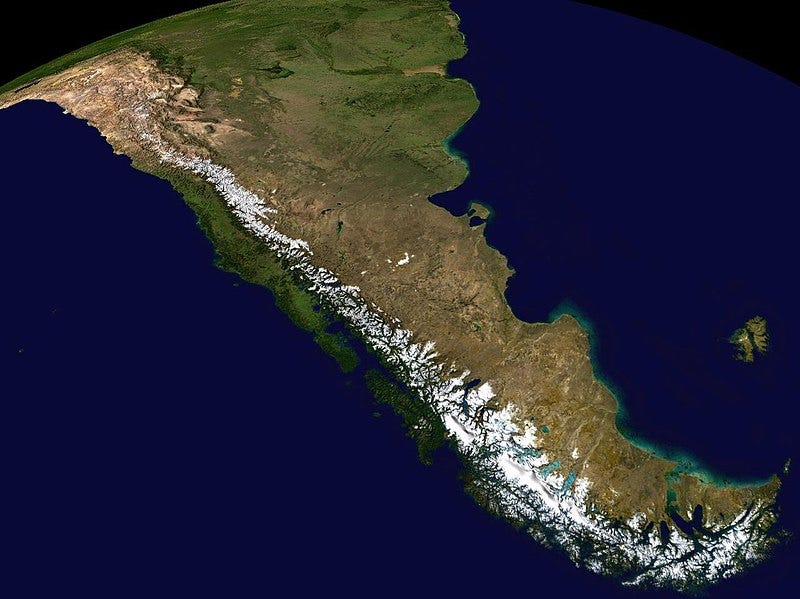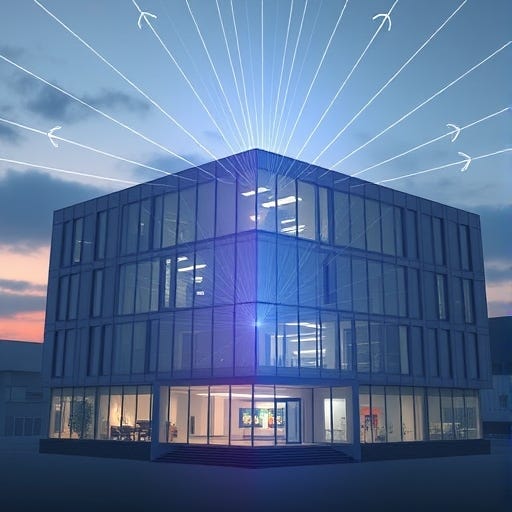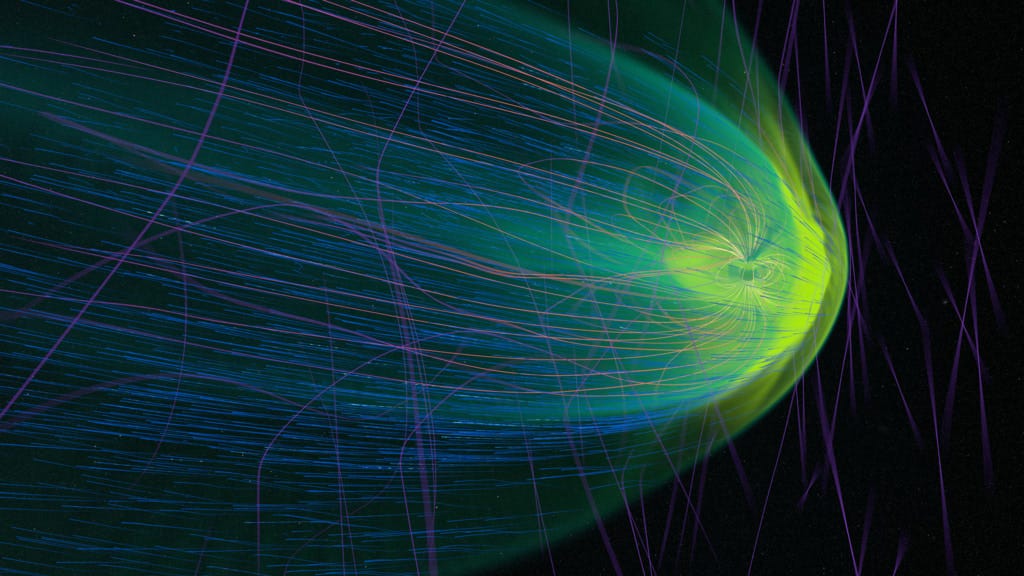How have fault zones and interrelated electromagnetic systems influenced Life?
Shaping Faults | Part 3.1
Shaping Reality
“Electromagnetic fields integrate all material systems, from atoms to galaxies”
- Rupert Sheldrake
Since 1997 the World Health Organisation has spent over $200 million on the “International EMF Project”. Their aim? Investigate risks associated with certain areas where both electrical and magnetic energy move together and interact, otherwise known as electromagnetic fields (EMFs). The WHO’s investigational lens has, for the most part, been exclusively locked on to artificially produced EMFs, such as the radiation emitted by power grids, or the effects of those conspiracy-clad “5G towers” that pop up all over the place. Consequently, a well-known body of research exists surrounding the second, third (and fourth etc.) order effects, both positive and negative, that technology-derived electromagnetic radiation (vis-à-vis artificial EM energy) can have on the human body.1 Less attention is paid to the antithesis of artificiality: mother nature.
After following a lead, starting somewhere along the Pacific Ring of Fire, we made our way along a causal chain spanning fault zones and the development of our own species' technological, social-cultural and belief systems. That was all looked at in Part 1. Our planet’s ability to produce electromagnetic energy dominated the narrative of Part 2. And this phenomenon of naturally produced EM energy, and the potential effects it has had on the history of Life, is where we pick up the narrative in Part 3.
'Cause we are living in an electromagnetic world
Habitation within our biosphere revolves around landscape. Where we inhabit has, for most of our history, depended largely on the features possessed by the space around us: mountains provided shelter and protection, while valleys provided fertility and hunting grounds. One feature, evident even at a cursory glance but not strictly natural in nature, involves a certain propensity for constructing physical complex infrastructure wherever we end up.
Constructing homes, schools, churches, businesses, institutions - our entire lives - atop grounds that has, evolutionarily, attracted our species into its folds does make sense. Unique ecological, geological and biodiverse properties along tectonic boundaries has resulted in many settlements being located along fault zones because we humans like shelter, and all of the creature comforts a roof and a few walls brings with it. Second and third order effects explored in Part 1.2 included the cyclical destruction of whatever infrastructure the local people built in the area. In a twisted process akin to destructive iterative design, this cycle of fall and rise, rise and fall, seems to have an effect on all sorts of cult-tech innovation that emerges at the localised, smaller scale of human organisation.2
What our ancient ancestors could not have fathomed was that, because of the geological composition of the lithosphere along tectonic boundaries, these feature-rich, attractive spaces were also feature rich in another sense: material structures like quartz, ovoline and rutile. With no use for the microscopic structures yet innovative to a fault, of course we came to use these materials in our building projects. Quartz, for example, is most commonly found within granite, and we know that the use of stone - the most impervious building material to time and mother nature - reigned atop the hierarchy of the built environment before the material science revolution of the 21st century caused it to come crashing down.
I mean, just take a quick look at Aswan and Giza in Egypt, or the Indus Valley in India and Pakistan; ancient demand for locating such building materials increased, and coupled with the biodiverse, fertile nature, more people migrated into fault rich areas. Look at countries like Kenya and Ethiopia amongst the East African Great Rift Valley, or all along the San Andreas fault line through California. Fault rich areas attract us for many reasons, more than what sits at the surface.
The Great Rift Valley in East Africa, the fault zone extending beyond the physical scars.
(CCA 3.0)
Rising topography suggests a change in lithospheric conditions, in this case the Andes Mountain Range along a very active subduction zone.
(CC PD)
But our ancestors surely could not have understood that, because of the chemical composition of the very stone they were now quarrying, just how very conductive the area itself was. How would they have understood that the atomic structure of the lithospheric material itself offers less resistance to EM energy passing through it? Whether a game of chance and, because these highly conductive areas can be “hundreds of kilometres in length and width” the vast space they cover was always likely to become populated as time goes by, or perhaps because of the fertile ecological niches that fault zones encourage, either way, whatever the case, it does not truly matter: Life seems to be attracted to fault lines, and that is the bottom line.
So far we have a situation where fault zones are known to produce and also interact with naturally occurring EM energy, and one reason for this is because of the material composition of the fault regions themselves. In the previous section we have seen that, in fact, the most conductive zones on the planet are located along fault lines, specifically subduction zones. Not only do the unique features and niches along fault zones attract our species because they aid in survival and thrival, but the landscape itself, the very environment we call home, contains highly conductive material because of the unique lithospheric conditions present along tectonic plate boundaries.
Now compound this with the understanding that the space between the Earth’s surface and upper bounds of the Earth-ionosphere cavity (around 50 km high) can also become highly conductive around subduction zones, meaning EM energy propagates more freely with less constraints on its movement. I had to take a step back and just think about that for a second. Around fault zones (especially subduction zones) the surface of the Earth is highly conductive, and so is the atmospheric conditions directly above it.
Not only are fault zones unique in their seismic properties, which we all feel because of highly kinetic events like buildings-collapsing but, whatsmore, these massive global system of what, in the most reductionist sense, amounts to a collection of cracks in the surface of our planet, are also highly conductive, and attracts EM energy whilst providing a space where such energy can move freely, without much resistance.
When we look at the map and see that many of the regions located along subduction zones are relevant to our previous correlations involving cult-tech innovation, belief systems and conflict dynamics (e.g. Japan, the West Coast of the Americas, the Middle East, Indonesia and Oceania), it begs the question: could there be more causal relations at play than just geographic determinism, universal archetypes, forced iteration and synergistic social, cultural and technological evolution?
We are, it seems, compelled to venture into the electromagnetic weeds a little further.
Tinfoil Hat, Anyone?
But threat not. If we go down the rabbit hole that we humans are constantly settling into spaces that contain more free, natural EM energy than other spaces, a counterpoint could be that modern infrastructure - the physical building materials that we structure our walls and roofs from - shield us from it. You can take that tin foil hat off your head now.
But hold on. As it turns out, brick, mortar and other common building materials are not just susceptible to the destructive kinetic “surface” waves like earthquakes, but, because of their low frequency, certain EM energy in the extremely low frequency (ELF) range of 3 - 30 Hz3 can also easily penetrate buildings.4 Maybe don’t throw that hat away just yet.
Sometimes occurring “within the frequency range of bio-electrical phenomena”,5 and given that EM energy travelling in the ELF range can travel vast distances (averaging somewhere between 10,000 - 100,000km), it becomes apparent that ELF range EM energy holds the capacity to penetrate buildings and, in doing so, could indeed affect bioelectric systems behind closed doors. If we take a suspected artificial case, like the so-called Havana Syndrome, we can clearly see how EM energy, in this case suspected to be directed microwave pulses, can certainly affect biological systems, even through modern building materials.
But all that is just artificial in nature. Natural EM energy surely can’t achieve such feats? Beginning where research is limited, tectonically produced electrical charges may cause short-term geomagnetic disturbances above ground in the GMF. These fields radiate as low-frequency electromagnetic pulses, also known as seismo-magnetic pulses. Seismo-magnetic pulses typically occur in the ultra-low frequency (ULF) range (0.01 Hz to 10 Hz) but in some cases can extend into the ELF range (below 100 Hz). The overlap between ELF and ULF lies within the 3 Hz and 30 Hz range. So, in some cases of tectonically influenced EM energy, the frequency suggests that these waves can travel vast distances and even penetrate modern building materials.
And, yes! - our bodies are the kind of bioelectric systems I am referring to. If we went to an 80's themed nightclub and the great words of Madonna washed over us: “Cause we are living in a material world”, I would be more inclined to hear: “'Cause we are living in an electromagnetic world.”
Unwittingly, it seems, we bathe in waves of electromagnetic energy, the rhythm of life humming all around.
But can our bodies really act as a conduit for these EM outputs? To form such a conduit, our bodies would need to act like an quasi-open electrical circuit. We could, of course, look no further than the 1990’s, when Becker’s “The Body Electric” discussed the profound connection between our body’s innate bioelectricity and its surrounding environment.
Since then, researchers have pointed out that Earth's natural EM fields, including the “Schumann resonance” (which we have seen already are sets of EM waves at frequencies around 5–50 Hz,6 charged by the continuous occurrence of lightning every second throughout regions of our atmosphere), are actually highly influential to how components of the biological system function, including essential areas like heart health and blood pressure.
Integrated so much so, in fact, that astronauts have had to carry a “Schumann resonance machine” with them up into space in order to regulate their biological system whilst not in Earth’s atmosphere. Indeed, recent studies have all pointed to the effect that natural, low frequency EM energy has on global human health. Clearly biological systems and EM energy have a deeply interconnected relationship, even before the advent of modern technology and the blurring of the digital and physical spaces.
Studies are now suggesting the highly causal role that natural EM forces have had on the development of life in general. Growing life inside a Faraday Box - consequently blocking all natural and artificial EM energy from interacting with the process of biological growth - results in an embryo developing in a completely different way when compared to a growth process in normal conditions. Electromagnetic conditions, or the lack thereof, affects the way in which life grows. Even our bodies have developed miniature Faraday-like systems to reduce external EM energy from disrupting cellular communication. We have evolved side-by-side, or more like from within, a biosphere charged by an intricate and natural system of electromagnetic energy.
Following this, we have seen that subduction zones are high conductive areas, where EM energy can propagate somewhat unobstructed. The question is, can this fault-line related energy propagation interact with other systems of energy that our biological systems - our bodies - relies on, like the Schuman resonances, and, if so, what significance could this have had on the evolution of Life in areas dense in EM energy?
Incidentally, here is where one of our earlier correlations from Part 1.2 may come into play. There is “a clear correlation between annual variations of the first Schumann resonance intensity and the tropical temperature over a 6-year span”, meaning that the EM energy system collectively known as the Schumann resonances not only influences our key bodily functions, it also acts “as a global thermometer for the tropics of the Earth”.7 EM energy does not just possess the ability to affect biological systems across a local to global scale, it already is.
Not only does this suggest certain EM frequencies can help promote the development of extreme life in tropical regions, when considering the most conductive zones on Earth are also found along fertile subduction regions, an intriguing causal chain presents itself:
Schumann resonances, and perhaps other EM energy existing within our atmosphere, interacts on a fundamental level with the biosphere (and possibly the hydrosphere), influencing the development of life occupying this space.
There exists the possibility that the conductivity of subduction zones along fault lines plays a key role in the promotion and intensification of diverse life in these regions. It is a big if, but one explanation for why we see an increased correlation between fault zones and biodiverse regions could be, once again, explained top-down:
Conductive Atmospheric Conditions → Highly Charged Earth-Ionosphere Cavity → Strong Schumann Resonances → “Charged” Biosphere → Dense Life,
bottom-up:
Fault Lines → Conductive Geospheric Conditions → “Charged” Biosphere → Dense Life,
and multi-directional:
Fault Lines → Conductive Geospheric Conditions → “Charged” Biosphere → Dense Life ← “Charged” Biosphere ← Strong Schumann Resonances ← Highly Charged Earth-Ionosphere Cavity ← Conductive Atmospheric Conditions.
I personally prefer the “patched” effect because it reminds me of old treasure maps (and correlating maps in a hurry is not as easy as it looks). We can see that conductivity of subduction zones (black triangles) sits alongside a majority of the planet's biodiverse regions (red). Combined with the idea that the Scumann resonances help regulate tropical temperatures, the case for EM energy affecting the development of life, across all scales, continues to grow.
So, as it turns out, our bodies can indeed act as a conduit for EM energy, energy that propagates top-down and bottom-up across our planet, with us in the middle. As we have discussed at the start, our species constructs highly populated places of historical significance atop stretches of the geosphere that not only sit along fault zones, but sit upon subduction zones - areas featuring highly conductive materials directly underneath them, and in many cases, highly fertile ecosystems above them.
One correlation we noticed earlier, namely between fault zones and zones of biodiversity may, in part, be explained by using the natural EM dynamics of Earth. When we venture down this rabbit hole it quickly becomes apparent that the interactions between us and EM energy has been happening since before we were a couple of shrews up a lonely branch of the evolutionary tree. Along that bare branch, back to the start of it all, is where we scurry next.
Shaping Early Life
Recent in-roads into “geomagnetobiology” has culminated in the following hypothesis: Earth’s GMF has quite literally shaped the evolution and developmental progress of biological life since its earliest origins.8
Already, by integrating the “Four Spheres Model” (FSM) (1. Atmosphere 2. Hydrosphere 3. Biosphere 4. Geosphere) with the magnetosphere, we have seen how the interconnections between Earth systems, especially those involved in seismic activity across fault lines, along with those systems involved in keeping the geomagnetic field (GMF) extending around and out of our biosphere, are highly interrelated. Whilst I am hesitant to go as far as calling the entire interaction synergistic, the manner in which they behave individually and act as part of a collective network at this point in time and space is compelling and, at least for me, somewhat comforting.9
The “fifth sphere” - the magnetosphere; a massive, complex system of EM energy that heavily influences Life on planet Earth.
(CC PD)
Especially compelling as, just this year, scientists have discovered the oldest evidence for our Dear Old GMF as we know and love it today. Estimates now believe the essential magnetic field, including the magnetosphere and the GMF, is over 3.7 billion years old. Interestingly, when we look at a timeline, life itself arose not that long after the formation of the GMF and other essential electromagnetic components, around 3.5 billion years ago - a mere 200 million years after. No doubt the relationship between the GMF and Life has been intertwined since the very assemblage of both. That suggests a deep web between the FSM, the magnetosphere, EM energy production and, yes, Little Old Life. But how could this web be shaped?
If we think back to what we saw in Part 2, Energy Generation, and specifically back to Faraday’s “lines of force” - the description of the physical structure of an EMF when exuding itself onto the surrounding environment - we come upon a helpful heuristic when wanting to imagine the shape that information takes when being transferred between, say, the GMF, or sources of SEM energy along fault lines, and Life.
Looking at this 2021 map of the GMF, you will notice the lines of force are being represented by continuous lines, their density (how close they are) indicating the strength of the magnetic field in that specific area (like a contour map - the closer the lines, the steeper the field). Whilst we can only map GMF lines using 21st Century technology, animals are able to use “both the inclination and the intensity of the GMF in a given place on Earth” as a source of information as to the whereabouts of its exact location.
GMF’s appearing like contours across a map of the Earth. Are these representative of lines of force as a way of imagining how information is transferred from EM energy sources to biological systems?
(CC PD)
“Magnetoreception” is not just a plot twist in a cheap sci-fi film, it helps certain species create both one and two-dimensional maps of the planet using the EM energy present in the global environment.10 It is also a direct example of the shape of information being passed between natural EM energy systems and biological systems. Using Faraday’s lines of force to think about energy transfer may, it seems, be a helpful heuristic after all.
Digging further into the mechanisms enabling long-distance bird migration, recent studies have pinpointed a certain flavoprotein present in bird eyes. When a blue light receptor called cryptochrome 4 (CRY 4) was found, one explanation became known as the Quantum Compass Theory. CRY 4 molecules are activated by blue light, triggering a quantum reaction in which pairs of radicals (electrically charged molecules with unpaired electrons) are formed. These radicals' spin states are influenced by the Earth's magnetic field. The orientation of these spins may generate different chemical signals, which the bird's brain could interpret as directional cues, leading to the construction of the 1D or 2D maps mentioned earlier, a system of EM energy that is perhaps structurally-adjacent to the lines of force heuristic.
Ways of visualising the various electromagnetic systems involved with Earth - in this case the magnetosphere. I cannot help but think of the biosphere, and Life’s place within it, amongst all this energy.
(CCA 4.0)
Whilst the Quantum Compass Theory suggests that the CRY 4 mechanism “might… allow animals to sense the Earth’s magnetic field”,11 since CRY4 is located in the retina it does not hurt to speculate that this EM information is superimposed onto the bird's visual field. In this case, birds might perceive magnetic fields as visual patterns or a faint overlay of directional cues, such as gradients, bands, or "arcs" aligned with the GMF (although I am secretly imagining a Tesla-esque interactive screen in the Homing Pigeons mind's-eye). Speculating more so for the sake of it, birds might see bright blue bands or arcs superimposed on their environment, corresponding to the magnetic field lines. Birds might truly be travelling in style.
Wild speculation aside, whatever the case the key takeaway is that biological systems can benefit from, and interact with, the systems involved in producing Earth’s EM energy. Why birds and insects but not us? Could we ever hope to develop this sense? What benefits would be bestowed upon us?
Questions galore, first and foremost the CRY 4 navigation research is a case study into the mysterious realm of coevolution between biological systems and Earth’s electromagnetic systems (embodied previously in the Four-Sphere Model). Venturing down this route a little further, it appears this coevolutionary relationship between EM energy and biological systems results in significant changes to the function of the biological systems. Perhaps due to birds having spent more “evolutionary time” on Earth (around 165 – 150 million years) their biological systems have spent longer within a biosphere charged by the plethora of EM and SEM energy, and so have developed novel strategies to utilise EM energy to their advantage. Maybe our species, anatomically modern for only around 300,000 years, is merely playing catch up.
From influencing plant evolution to no doubt providing early organisms the spatial information necessary to be “able to find [the] most convenient habitats” and migrate over long distances,12 the GMF, through unseen fields of EM energy, perhaps imagined like magnetic lines of force, provided the structure needed for early lifeforms to organise itself within the space afforded to them in their pocket of the biosphere. This niche, as has been seen with the correlation between biodiversity and fault zones, is often seismically dense. This niche, as we have discussed, contains all hosts of Life, including us humans, with our complex infrastructure. Life, littering the avenues of fault lines, has clearly evolved within a unique electromagnetic ecosystem.
See: Saunders, 2003; Kivrak et al, 2017; Kerick, 2022.
Such as polygonal masonry, and complex belief systems, possibly encoding information about natural disasters - see Part 1.2.
Imagine wave frequency and material penetration as water interacting with a sheet of paper. High-frequency waves are like a fast spray of fine mist: the water droplets are small, high-energy, and hit the surface of the sheet in rapid succession. Because of their high energy, they tend to spread out and get absorbed quickly and don't penetrate very deeply. In contrast, low-frequency waves are like a slow but steady jet of water. The water moves more slowly and smoothly, with larger droplets that are less energetic. These droplets are better able to penetrate the paper's surface and travel through to the other side.
See: Jackson, 1999, Pp. 310-312.
Persinger et al, 1973, P. 1152
Because the alternatives across space and time are less habitable and hospitable (e.g. Ice Ages, or Volcanic periods).
Zhang & Malkemper, 2023. See also: Wu et al, 2020 & Xu et al, 2021
Erdmann et al, 2021. I’ll just leave the somewhat obvious comparison to Chardin’s “Noösphere” here.










